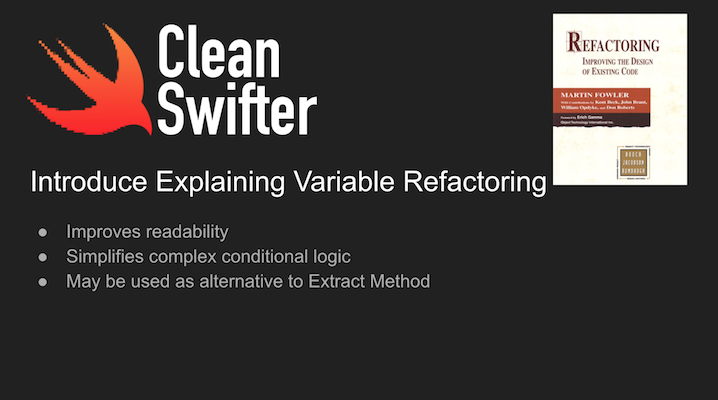In “Refactoring, Improving the Design of Existing Code” by Martin Fowler, he presents the Introduce Explaining Variable refactoring.
Here’s a video walkthrough of the Introduce Explaining Variable refactoring in Swift and when you might want to use it:
Video Transcript:
Hey, what’s up everybody, it’s Andy the clean swifter, and I’m back to show you another refactoring from Martin Fowler’s book, “Refactoring, Improving the Design of Existing Code.” This week, I’m going to show you in Swift I’m going to show you the refactoring “Introduce Explaining Variable.” This refactoring can be used as an alternative to Extract Method when you have a complex piece of code that you want to simplify. The way that you’re going to simplify it is to create a new temporary variable that is well named and can be used to break up some complicated logic. Imagine sometimes you’ll be creating a complicated if statement to represent some conditional code, where there’s a lot of different things you need to check. All of a sudden you end up with several different and clauses, a couple different ors, and some parens grouping them, and before you know it, you’ve created a piece of very hard to read code. That’s bad because it’s a way to introduce bugs. It’s easy to accidentally change the logic of that statement such that you create a bug. Temporary variables can be used to break it up. You’ll take a piece of that if statement, that conditional cause, extract it into a temporary variable that is well named, and then reference that temporary variable in the conditional clause to then help explain it to the reader. You might instead use extract method to put it into a brand new, well named, method that returns a boolean that also helps explain its purpose to the reader, but in the case that you don’t want to do that, sometimes it may not be worth a method of its own, you can use this to introduce a variable to help explain the complicated conditional code. Let’s take a look at Introduce Explaining Variable:
Here’s a view controller similar to last week, where in this view controller there are two strings that represent a first and last name, a label that will be set with the name, and then also a welcome label which will give a customized welcome message based on something about the name. Down here in viewDidLoad() we’re going to set the nameLabel to be the fullName but now here we’re going to do some conditional logic to set the welcomeLabel based on the person’s name. Right off the bat, I’m trying to read this code and I come across this if statement and I see there are at least four different things being checked in order to determine how the welcomeLabel will be set. This to me isn’t very readable. We can use this refactoring to help improve the readability of this code. In order to use the refactoring, Introduce Explaining Variable, what I’m going to do is that I first need to understand what the condition is checking, and then I’m going to find a way to break it apart. Looking at this, it’s checking if the firstName starts with “A” and the lastName starts with “A” and the firstName ends with “A” and the lastName ends with “A” the welcomeLabel is set with a message that indicates they have a lot of “A”s in their name because just like my name “Andy”, “A” is the best letter in the alphabet. What’s the explaining variable I’m going to introduce? Well I could create two variables to each represent whether each name starts and ends with “A”, or a variable to represent whether both names start with “A” and another to represent that both end with “A”. For instance, let firstNameStartsAndEndsWithA, and to set that, I’m going to take this code right here, cut it out, and paste it in there. So that boolean represents the fact that firstName may or may not start and end with the letter “A”. And now I’m going to do the same thing for lastName. Now update the original if statement to represent the original behavior, and you should have unit tests to actually verify this, but it’s not a requirement. Now reading through this updated code, it is easily read aloud. I can look at the if statement alone, skipping over the variable definition, and understand the logic the if statement is checking. Well named temporary variables go a long way to give you quick readability of a complicated if statement. Now I can read this and understand if the first name starts and ends with “A”, and the last name starts and ends with “A”, I give a specific welcome message that they have a lot of “A”s in their name, otherwise their name is boring. Fowler does describe you could take this even further, and instead extract both of these new temps into their own method which might be called “lots of As in name” and then call that method from the if statement. It’s just one alternative. In this case, I choose that using temporary variables is appropriate, and leave it at this.
There you have it, that’s the Introduce Explaining Variable refactoring and it’s a way that you’re going to reduce the complexity of code specifically often times in complicated conditional clauses by introducing temporary variables. I hope you liked this refactoring, Introduce Explaining Variable from Martin Fowler’s book, “Refactoring, Improving the Design of Existing Code.” You can buy the book through my Amazon Affiliate link in the description for this video. I’ll see you next time.
Happy cleaning.

